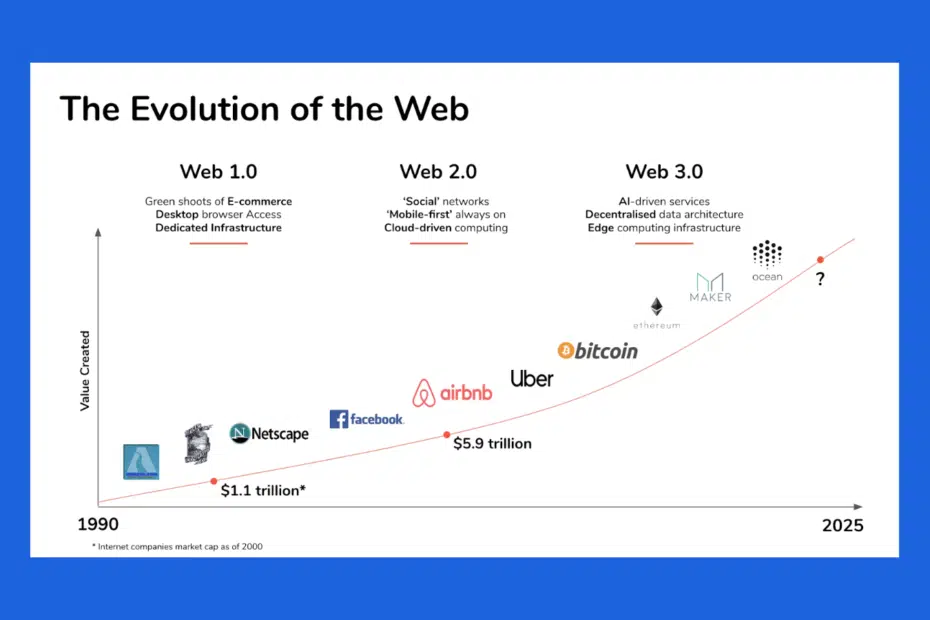Over four billion users access Web 2.0 platforms daily, which becomes more surprising when one accounts for the fact that the platforms did not exist 20 years ago. Across the globe, it has become standard practice to access and engage with technological platforms that have wormed into every corner of our lives so quietly and thoroughly that it can be difficult to recall what everyday life was like before they came. Yet, despite their unrivaled success and ubiquitous presence, we are at the height of the next digital revolution – Web 3.0.
What is Web3 (Web 3.0)?
The journey of the Internet from the birth of Internet Relay Chat (IRC) to the advent of modern Social Media platforms has been nothing short of extraordinary, but the transition from Web 2.0 to Web 3.0 (the Semantic Web age) will be the most fascinating. Web 3.0, which is also referred to as the “Semantic Web,” would see the integration of Artificial Intelligence (AI) and Machine Learning (ML) into the internet. The objective of Web 3.0 is to create an inter-connected, open, and intelligent web where websites and web applications would sync with Machine Learning algorithms to deliver content as per the liking and behavior of an individual.
Rather than generating content neatly divided between creator and consumer, as with web 2.0 platforms (think of Facebook and YouTube), web 3.0 imagines a much more fluid and dynamic conversation—like real-world engagement. The information will also be completely customized, adjusting what we see individually based on what we want and need rather than the same search results or recommendations for everyone.
Most importantly, web 3.0 will align the machines with human understanding. Machines will be able to read, understand, and interpret data the way humans do, and they will be able to have far more radical and far more accurate engagement with the physical world.
Tracing the Internet’s Evolution
Web 1.0 – The Static Web
The era of the World Wide Web 1.0, also known as the “Static Web,” was centered on the centralization of content and resulted in a user experience in which information was typically published from a centralized source without any kind of collaboration or dynamic content — early visitors to webpages, for example, could not bookmark or add to the content they were reading.
Web 2.0 – The Social Web
Web 2.0, also known as the “Social Web,” built on this model by turning the internet into a more collaborative space. As more and more people began to consume information and even more began to produce it — including the technical expertise required for creating web applications — a network effect emerged. For some early versions of Web 2.0, user contribution and feedback were limited to content comments or edits.
Web 3.0 – The Internet of Trusted Hyperlinks
Web 3.0, or “The Internet of Trusted Hyperlinks,” attempts to make further strides and aims to use blockchain, the Internet of Things (IoT), and even virtual reality (VR) to personalize the web even more than what is made available to us by Web 2.0. In other words, rather than being limited to content creation and distribution, as was made possible by Web 2.0, the next web aims to make the information taking place within web applications device-agnostic.
Embracing Decentralization with Web 3.0
Web 3.0 is about taking back control of the internet and freeing it from the clutches of the network giants who dominate it. A technology called blockchain is what makes all that possible.
Blockchain technology is the underpinning of Web 3.0. It enables the creation of decentralized applications, or dApps, run on a peer-to-peer network rather than on a centralized server. This means that users would no longer have to give up control of their data. They would no longer need to trust big technology companies to keep their personal information safe; they wouldn’t need to build their businesses on top of centralized platforms that could suddenly change the rules, cutting off their traffic and shattering their revenue streams.
Distinguishing Features of Web 3.0
The promise of Web 3.0 is its distinguishing features:
- No Single Point of Control: By decentralizing the internet, users’ data remains in their hands, significantly reducing potential interference from governments or corporations.
- Greater Interconnectivity: Data interconnectivity will grow exponentially, with AI and ML algorithms using this vast information to curate personalized user experiences.
- Enhanced Browsing Efficiency: Enhanced semantic understanding will make search engines more adept, simplifying the user’s quest for accurate information.
In addition to addressing the technical shortfalls of the internet, Web 3.0 is also looking to improve advertising. By integrating AI, blockchain, and other emerging technologies into every aspect of the new web, technology developers believe Web 3.0 will see a digital advertising ecosystem emerge that is more highly personalized and relevant to the individual.
In Closing
Transitioning from Web 1.0 to Web 2.0 and looking ahead at Web 3.0, we see that humanity is progressing toward a more interactive, intelligent, and equal online world. Integrating blockchain with the power of AI is not just about technology’s potential — it represents a forward move into a more democratic, user-driven digital era that reflects and resolves the needs and aspirations of of its users. Web 3.0 is not just evolution. It’s revolution.

